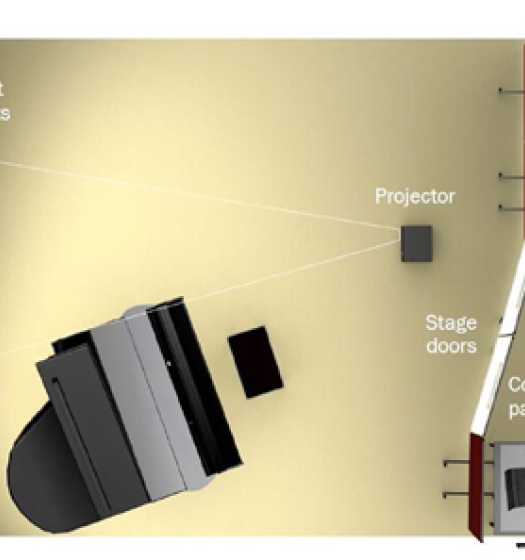Dressed for a concert, soprano and Early Music student Leah Weitzner recently sang to an empty room on the eighth floor of the Elizabeth Wirth Music Building.
“I could feel the really heavy light on my face and that made me get a little nervous because it felt like I was on stage,” says Weitzner, recalling her experience in that room. She is one of the lucky few who have tried the new Performance Laboratory, which was installed at the Centre for Interdisciplinary Research in Music Media and Technology (CIRMMT) in January 2021.
This lab is the brainchild of Professor Aaron Williamon, director of the Centre for Performance Science at the Royal College of Music (RCM) in London. He is also a Dean’s Chair at the Schulich School of Music, a visiting position funded by the Schulich Foundation.
According to Williamon, the adage that it takes 10,000 hours of practice to become an expert musician doesn’t tell the full story. “It’s not just a matter of accumulating time; it’s about putting in the right quality of time,” he says.
One of the things that affects the quality of practice is the setting. Williamon explains that typical practice rooms tend to be dull, low-risk environments that bear no resemblance to the stimulating atmosphere of a concert venue. Students may be perfecting their technical skills in these rooms, but they are not learning how to manage the stress of performing.

Leah Weitzner was among the first to try the Schulich School of Music's new Performance Laboratory in winter 2021.
In trying to bridge this gap between practice and performance, Williamon developed a simulation for music students at the RCM, drawing inspiration from the methods used to train surgeons next door at Imperial College London.
“What we found is that the level of physiological change that happens before people go out to perform in our simulation is directly comparable with the level of change we see in real performances,” explains Williamon, who used electrocardiograms to measure variations in musicians’ heart rates before and during the simulation.
Now, with the help of colleagues at the Schulich School of Music, Williamon is bringing his game-changing simulation to McGill students.
Inside a simulated performance
“It really felt like this is probably the closest thing to performing that you could get,” says Weitzner, who was impressed by her first experience with the simulation.
When she first walked into the Performance Laboratory, Weitzner found herself in a backstage area with monitors showing an audience awaiting her performance. She could even hear them chatting quietly from behind the curtain.
I noticed that a lot of the audience was swaying as if they were listening to exactly the rhythm of the piece that I was singing, and it felt really live. I wasn’t exactly sure how that was happening but there was something oddly real about the experience.”
Williamon explains that having this backstage area, as well as a backstage manager and CCTV footage of the simulated audience, is integral to building the illusion. “It's all part of the setup to get people in that performance frame of mind.”
Walking out to the sound of applause, Weitzner could see her audience on a large TV screen, which was positioned to give the impression of looking down from the height of a stage. She began by singing a cappella and then self-accompanied on viola da gamba.

Diagram of the performance simulation room at the Royal College of Music in London, which was the model for the Performance Laboratory at the Schulich School of Music.
Throughout her performance, Weitzner was surprised by how responsive and engaged her spectators were. “I noticed that a lot of the audience was swaying as if they were listening to exactly the rhythm of the piece that I was singing, and it felt really live,” she says. “I wasn’t exactly sure how that was happening but there was something oddly real about the experience.”
Dr. Isabelle Cossette, an associate professor of music education at Schulich and the former director of CIRMMT, has been facilitating these sessions. She explains that the exact nature of the interactive audience is not revealed to students, which heightens the illusion.
However, Cossette does ask students whether they would like a more positive, negative or neutral audience reaction – or a mix of all three, which is what Weitzner chose. Noises, like a cellphone ringing or a person coughing, can also be introduced during the session so that musicians can practice dealing with distraction, Cossette explains.
Moving beyond performance anxiety
When he began this project, Williamon was looking to create a space for musicians to deal with their performance anxiety. But over time he noticed that there are many other things people want to work on, like how to gracefully take a bow or project presence on stage. The simulation has since expanded into a comprehensive pedagogical tool that can be used to address multiple dimensions of performance.
Cossette is using the simulation in her Performance Strategies class, and she plans to get other McGill professors on board. “The idea is for students to perform and then engage with their professor to discuss all the aspects of performance: performance anxiety, demeanour on stage, poise, concentration, memory,” says Cossette.
For Weitzner, one of the most valuable parts of the experience was receiving a video recording of her performance afterwards and analyzing it in Cossette’s class. “I was really able to learn a lot about myself as a performer and at the same time really practicing gratitude and awareness of how I am when I perform in the moment.”
The simulation has also been an unexpectedly useful tool during the pandemic, as in-person concerts have all but disappeared. “That was another reason why I was so excited to try this. Just the feeling of performing again in front of an audience definitely elevated the experience,” says Weitzner.
Next time, she wants to try performing for the virtual audition panel, which is the second option that musicians can choose when they use the Performance Laboratory. “In the past year, I haven’t had any auditions and I want to remember what it feels like to play in front of just three people with their eyes on you.”
A holistic approach to performance education
The Performance Laboratory is just one component of a larger project that Williamon and Cossette are leading called the Performance Science Initiative, an ambitious multidisciplinary collaboration between the Schulich School of Music, CIRMMT, and several other departments at McGill.
Aiming to inspire new ways of thinking, the initiative is based on the idea that musicians can learn from how “performance” is approached in other fields, like medicine and sports science.
One of the initiative’s “grand challenges” is enhancing the health and wellbeing of musicians, who have performance-related pain levels that are “directly comparable” to what we see in athletes who play contact sports, Williamon explains.
Cossette acknowledges that the traditional “master-apprentice model” remains an important part of how musicians are trained, but she would like to a see a move towards more “evidence-based and interdisciplinary strategies that will bring music education into the 21st century.” She envisions a future where musicians are supported by a team of coaches and trainers with different specialties, much like in the world of professional sports.
“At McGill, we want to create a safer and more efficient learning environment for performance that is sometimes supported by technology, sometimes by science, sometimes by the humanities – you name it. It’s really a multidisciplinary approach to training someone as a highly skilled musician,” says Cossette. “And the Performance Laboratory is one step in that direction.”
Innovative projects like the Performance Laboratory are part of the Schulich School of Music’s plan to reimagine the future of music performance, with the help of donors. Find out more.

